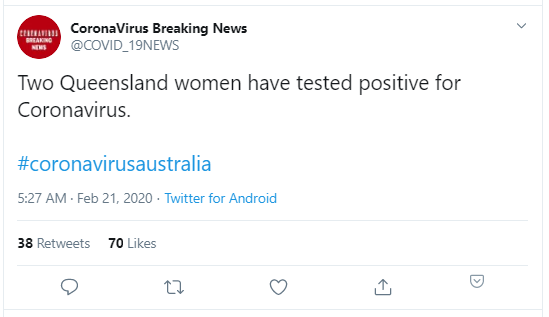Let's hover!
Author: Mike Caulfield
Caulfield, Mike. “Let's Hover!” Sifting Through the Pandemic, 28 Feb. 2020, infodemic.blog/2020/02/16/lets-hover/.
Summary
- To find out more about a source, hover over the link to the user profile (desktop browser) or click it (mobile).
-
When you hover, ask yourself
- Is this source what I thought it was?
- Is this source credible enough to share without any further checking?
- Hover every time, not just when you are suspicious.
OK, this is the our first technique of our “Investigate the Source” move, but it’s also a great example of what I mean about simple things that people just don’t do. We’re going to focus on Twitter here, but all major social platforms have similar features.
So here’s an example: a video that is captioned as the Chinese government rounding up Covid-19 patients forceably.

My first step is not figuring out whether the claim is true. My first step is to figure out whether I can take the source’s word for it all on its own. And so I hover over the link to the profile, and find the answer here is no, I can’t. This person isn’t in any particular “position to know” — they are not a reporter, not a direct witness, not an expert.

Verification checkmarks are good, but it matters what the checkmark is for. In general, we want expertise or professional knowledge that is fairly narrowly defined. Take this person for example:

When we hover we find that they are a meteorologist. They are probably still sharing something true, but we’d want to independently verify before sharing, because this is not their area of expertise or reporting. Close, but not quite!

The following source, on the other hand, is likely good to go — a reporter from the Sacramento CBS affiliate reporting on the first case in Sacramento in what seems a professional capacity. Share away!

A question to ask yourself when hovering — “Does this look like what I thought it was?” Here, you might think this was a major Swedish newspaper:

But hovering you notice there’s no checkmark and there’s a smaller amount of followers than you’d expect for a big paper. It may be fine, but you have to do more checking.

Be careful assessing niche expertise — it’s harder than assessing journalists. A health reporter employed by a reputable publication doing reporting in a specific area can be assumed to be following certain professional standards, and, just as importantly, doing their best to summarize expert consensus, not advocating individual views.
This person is verified and a virologist, and might be a great source! But without expertise of our own or a rock-solid affiliation of this tweeter, we’d need to know a lot more to assess their claims and reputation.

Most importantly, just because a source isn’t known to you or trustworthy on its own, it doesn’t mean the story isn’t true! Many substandard sources share real news. It just means you need to do a bit more verification before you share, usually by finding a better source! The following is from one of the many news aggregators that have sprung up, and can’t be trusted on its own, but you can always find a better source.

That’s the basics. If you want to learn more little bit more about this technique and why it’s important to hover every time you have a strong emotion, sense of surprise, or urge to share.





0 General Document comments
0 Sentence and Paragraph comments
0 Image and Video comments
General Document Comments 0

